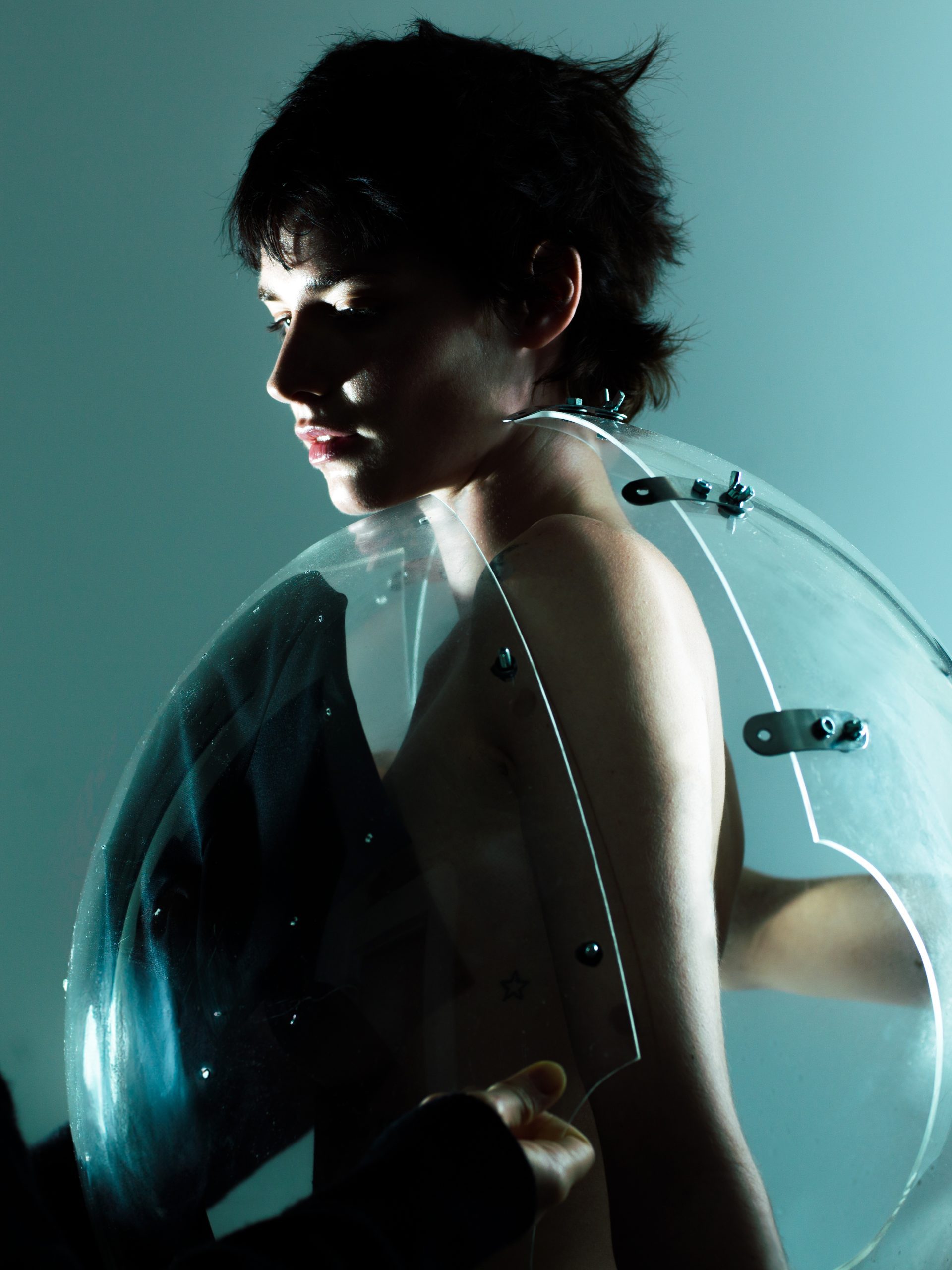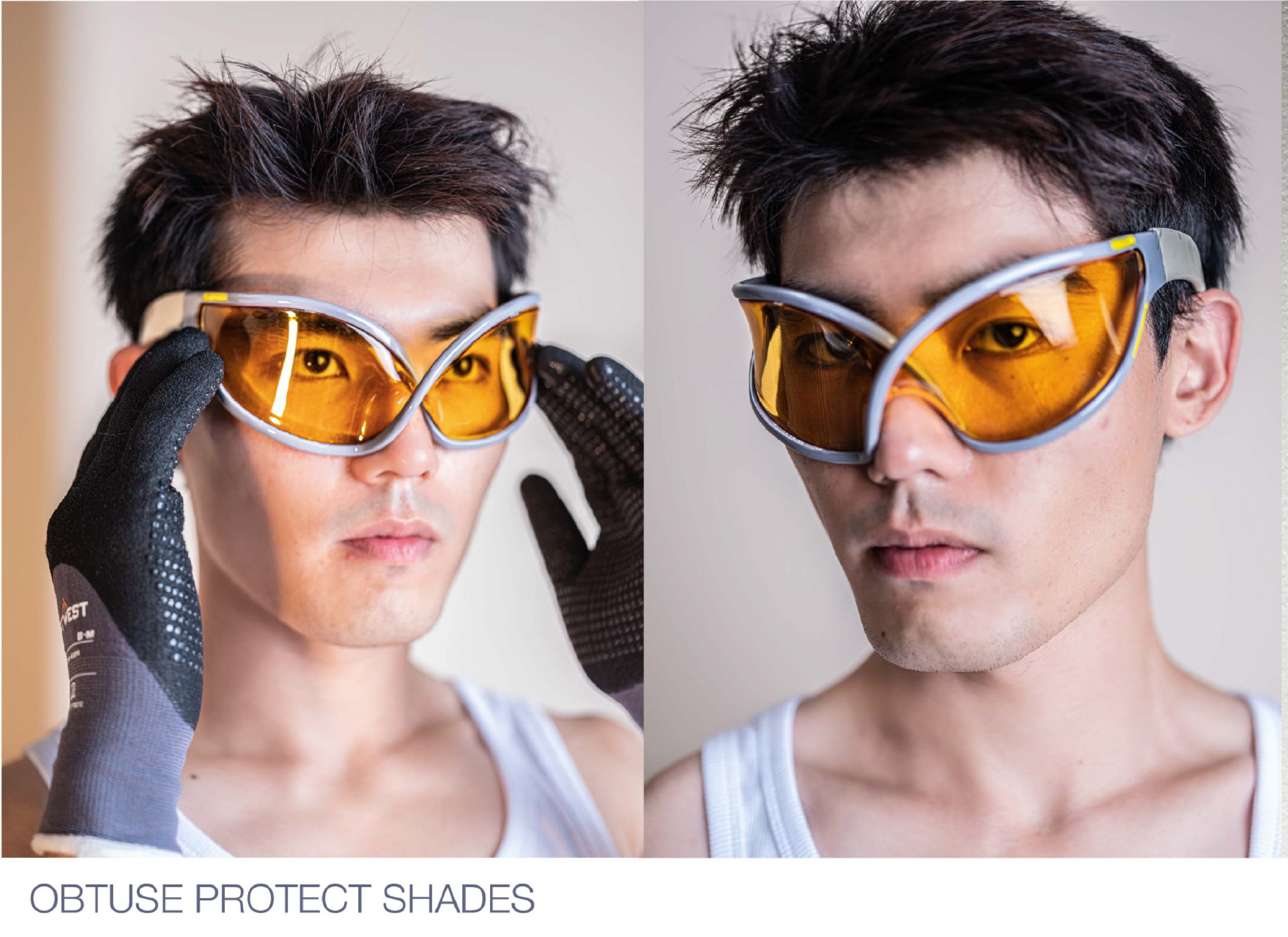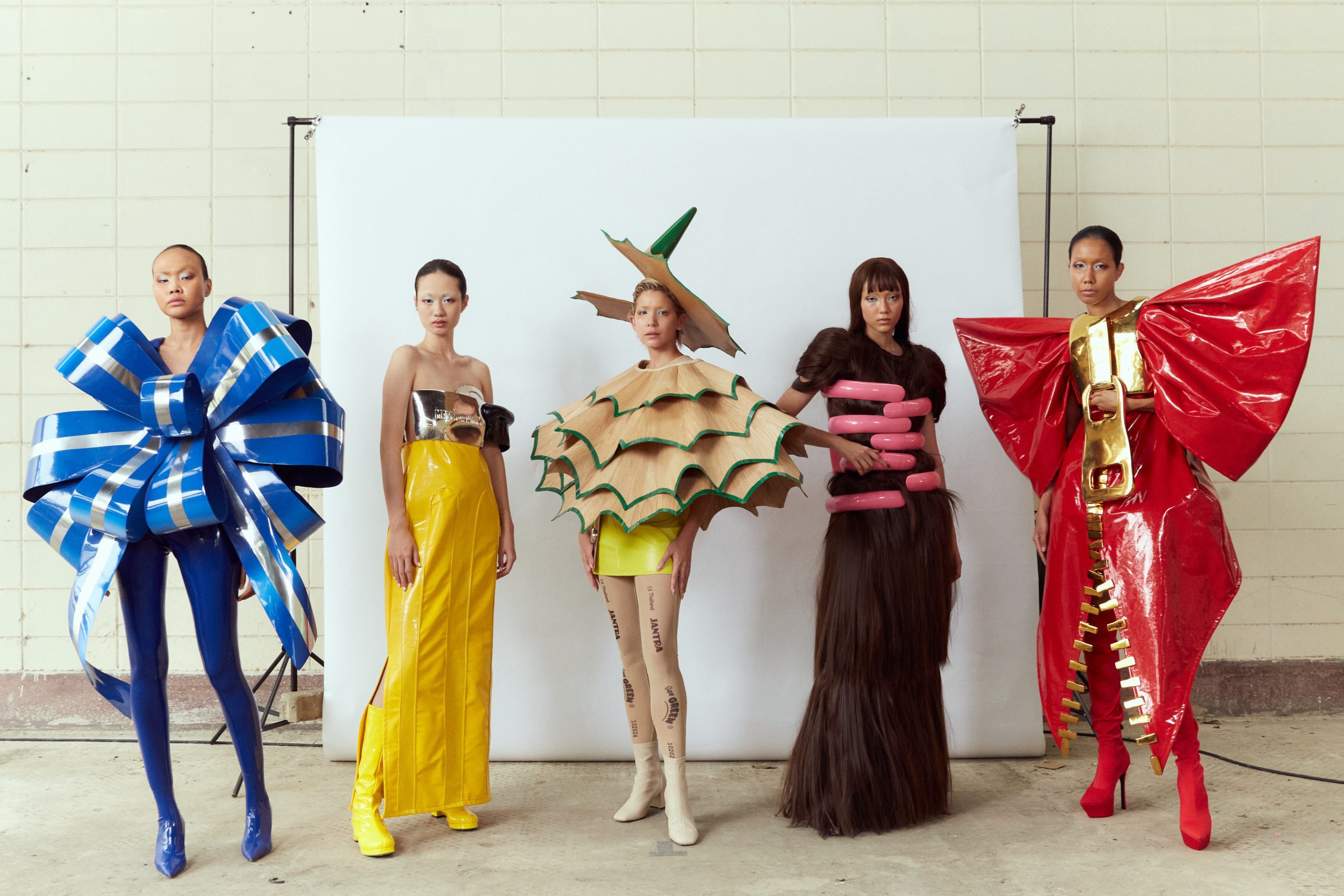1. Can you tell us more about the concept behind your new collection, 32 EAST, Eastern Futurism? How did the idea of aliens and Eastern Europe intersect to create this unique theme?
I want my work to consistently challenge social norms while simultaneously delving into the historical past and its connection to the future. While each collection introduces a fresh concept, I draw inspiration from my heritage and upbringing in post-communist Romania. By merging these influences with futuristic elements, I want to create a captivating blend of post-apocalyptic glamour. The starting point of 32 EAST was an article highlighting a medieval painting discovered in a Transylvanian church, supposedly depicting the first portrayal of extraterrestrial life with a UFO-like object. Transylvania, the land of conspiracy theories, inspired me to design attire reminiscent of ancient aliens.
- You mention that the term “alien” can encompass everything we can’t categorize. How does this notion of the alien influence the designs and overall aesthetic of the collection?
It was always my desire to create clothes that don’t correspond to a specific point in time. Rather than clearly visually referencing something, I want to create a realm of experimental realism where past, present, and future all live together, simultaneously, defying the limitations of a specific era. I think the only way of imagining a possible future requires acknowledging the influence of the past and honouring traditions.
We keep depicting aliens as green extraterrestrial beings, I perceive them as individuals who don’t quite fit into society’s ‘standards’. Aliens are essentially the misfits and outcasts who have been alienated.
- In what ways does 32 EAST aim to represent and connect with the outsiders, observers, and aliens of our society? How does it provide a platform for those who feel their access is constantly denied?
I have always been fascinated by individuals who defy societal norms and live their lives authentically and freely. “32 EAST” is a collection that celebrates gender fluidity and comprises 16 distinct outfits. Its primary objective is to delve into the concepts of visibility and liberation, offering a platform for exploration and expression.
- The collection is described as being dedicated to the outcasts abandoned by the mainstream. How does it challenge traditional fashion norms and embrace diversity?
This collection embraces a powerful dedication to those who have been marginalized and overlooked by mainstream society. It challenges traditional fashion norms by deliberately deviating from conventional standards of beauty and style, choosing instead to celebrate the uniqueness of individuals. By featuring designs that are evocative of post-apocalyptic Balkan folklore, the collection aims to redefine beauty standards and offer a sense of belonging and empowerment to those who may have felt excluded in the past.
- Could you elaborate on the political connotation mentioned? How does 32 EAST address political issues through its designs and message?
Europe finds itself divided along ideological lines, with the conservative East and the more liberal West. In the European context, Western countries dominate both the East European countries and the other non-EU immigrant countries. The relationship between Eastern and Western Europe exemplifies the symbolic dynamics of discrimination and belonging, determining who is deemed truly European. While most Eastern European countries are part of the Schengen area, enabling passport-free travel, Romania, Croatia, and Bulgaria remain excluded. This exclusion can make Eastern Europeans feel like outsiders, like aliens. It is this clash of cultures that I sought to portray through my collection.
For myself and my brand, it was never about inclusion but rather about embracing the richness of differences and creating our own space, a fantasy world where we are the main characters.
- What are some key elements or symbols incorporated into the collection that represent the fusion of Eastern European culture and futurism?
The fusion of East European culture and futurism is portrayed in this collection through the combination of prints featuring alien bodies and Transylvanian Religious tattoo symbols. These elements blend harmoniously, creating the illusion of ancient alien bodies onto different items.
Prints of alien bodies and Transylvanian Religious tattoo symbols, merge together to create the illusion of ancient alien bodies.
- Can you describe the color palette and materials used in 32 EAST? How do they contribute to the overall storytelling and evoke the essence of the concept?
The collection is made exclusively from deadstock materials, upcycled traditional embroidery and upcycled leather sofa covers. This season the colours are more muted and earth-toned. With an emphasis on prints and textures. Like Thorpe l’oeil prints of destroyed mining trousers onto duchess satin. I have this weird fascination with combining luxurious shiny fabrics like (the metallic liquid lurex with gold or silver inserts) with fabrics that are suggestive of sportswear like nylon and cotton.
- How does the collection bridge the gap between the familiar and the unfamiliar, creating a sense of curiosity and exploration for the audience?
By mixing traditional elements with futuristic shapes, this collection seeks to blur the boundaries between the known and unknown, resulting in garments that transcend any particular era. The juxtaposition of familiar details and futuristic armour-like forms creates a unique aesthetic that defies temporal classification.
- Are there any specific inspirations, cultural references, or historical contexts that influenced the creation of 32 EAST? How did you incorporate them into the designs?
The inspiration behind the draped and layered garments in my collection stems from traditional costumes from the south of Romania. In the past, jewellery was included in young girls’ dowries and worn for weddings. This often involved wearing a narrow leather belt worn over multiple layers of skirt. The belt was decorated with tin rivets and coins with punched holes. I used these coins as embellishments for hoods and on top of re-purposed old embroideries. I couldn’t overlook referencing the Eurotrash fashion trends of the 90s as well, such as sagging jeans and chunky shoes, which played a part in creating a distinct aesthetic.
- Fashion has the power to influence and provoke thought. What do you hope viewers and wearers of 32 EAST take away from the collection in terms of societal perceptions and inclusivity?
One’s identity encompasses far more than just race, gender, sexual orientation, or ethnicity. It is crucial to transcend the limitations of socially constructed ideas about personal identity and recognize the depth and complexity of individuals beyond these narrow categorizations.
- What challenges did you face during the creative process of bringing 32 EAST to life? How did you overcome them and maintain the integrity of your vision?
I think the biggest challenge was finding a middle ground between fantasy and functionality. This challenge resonates with numerous designers who have recently completed their studies in art schools. The pressure intensifies as renowned fashion houses exert their influence, often dictating the direction of trends. But you have to stick to your creative voice and find a community of people that share similar values/ideas.
- Could you discuss any particular pieces from the collection that you feel embody the essence of 32 EAST and its message? What makes them stand out?
The reinterpretation of the Babushka scarf, which is a hooded puffer scarf that can be worn in 6 different ways. The Dacian Jumpsuit is a combination of stretch Airtex fabric and a digital 3D print of the Dacian Draco- a politically symbolic Romania. Dacians are the ancient inhabitants of East Europe/ before the Romans occupied the region.
- Collaboration often plays a significant role in the fashion industry. Did you collaborate with any artists, craftsmen, or organizations while developing 32 EAST? If so, how did those collaborations enhance the collection?
I like to think of my collaborators as my team, as we are growing together on this journey and would love to continue working with them. I started working with Reiki Zhang who’s a 3D artist while I was in my final year MA at CSM, and we’ve been working together ever since on different projects. Like the AI shoot where she joined forces with Chloe and the Art director and photographer Fido Chen. Xuanli Yung worked on my logo and the campaign for 32 East. Armando Xie works on the website, and we also have a 3D project on the way.
For the shoes, I collaborated with the amazing Omel Chuck Atelier that’s based in Kazakhstan.
Words by Rafaela Pestritu
Interviewed by Fernanda Ondarza, Editor in Chief of GLITCH Magazine





